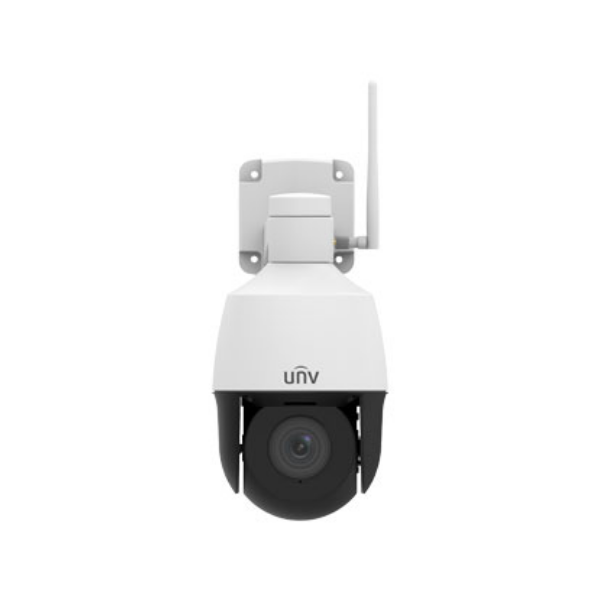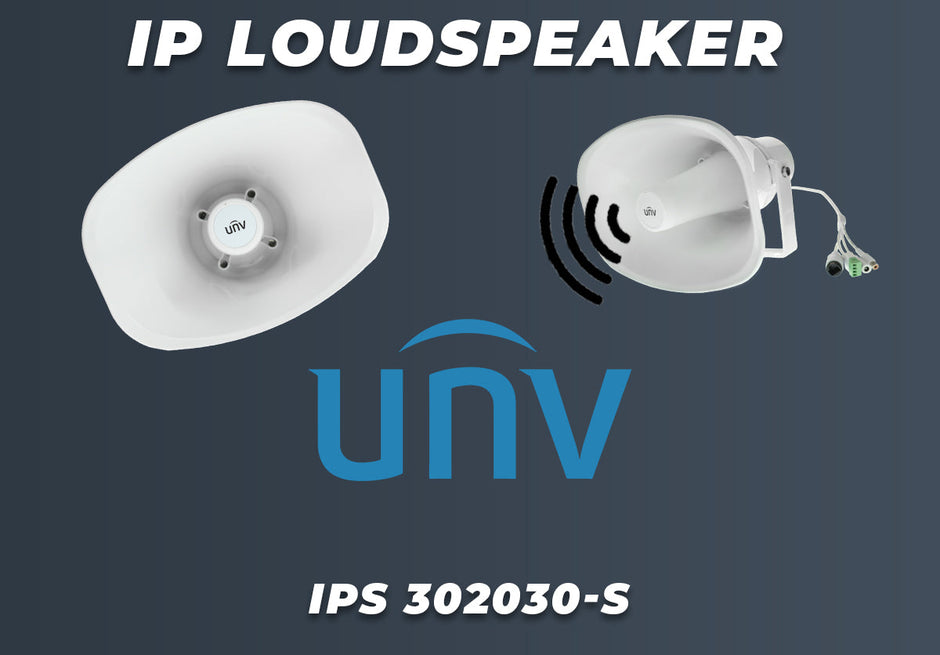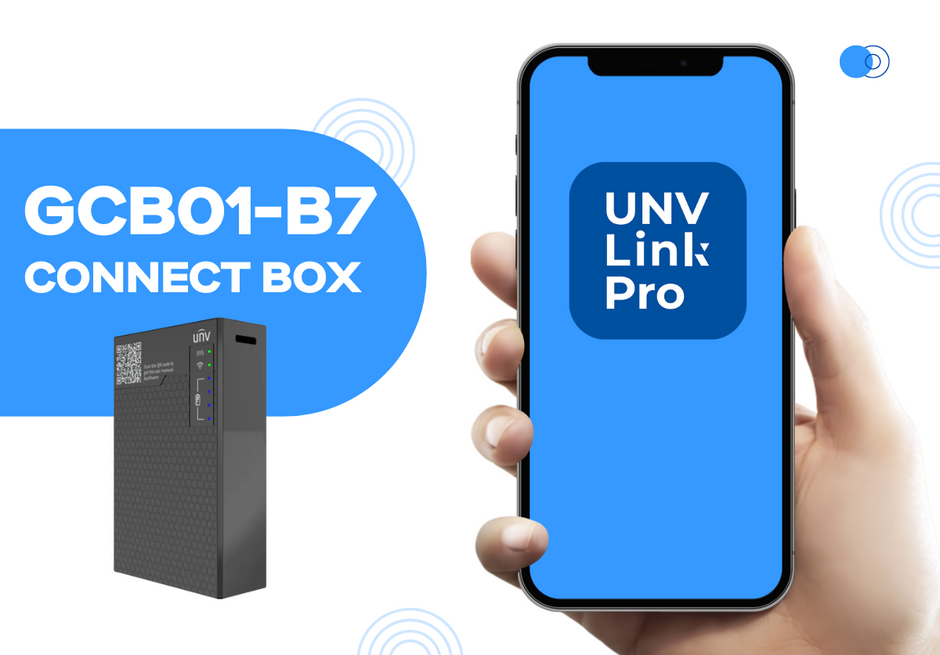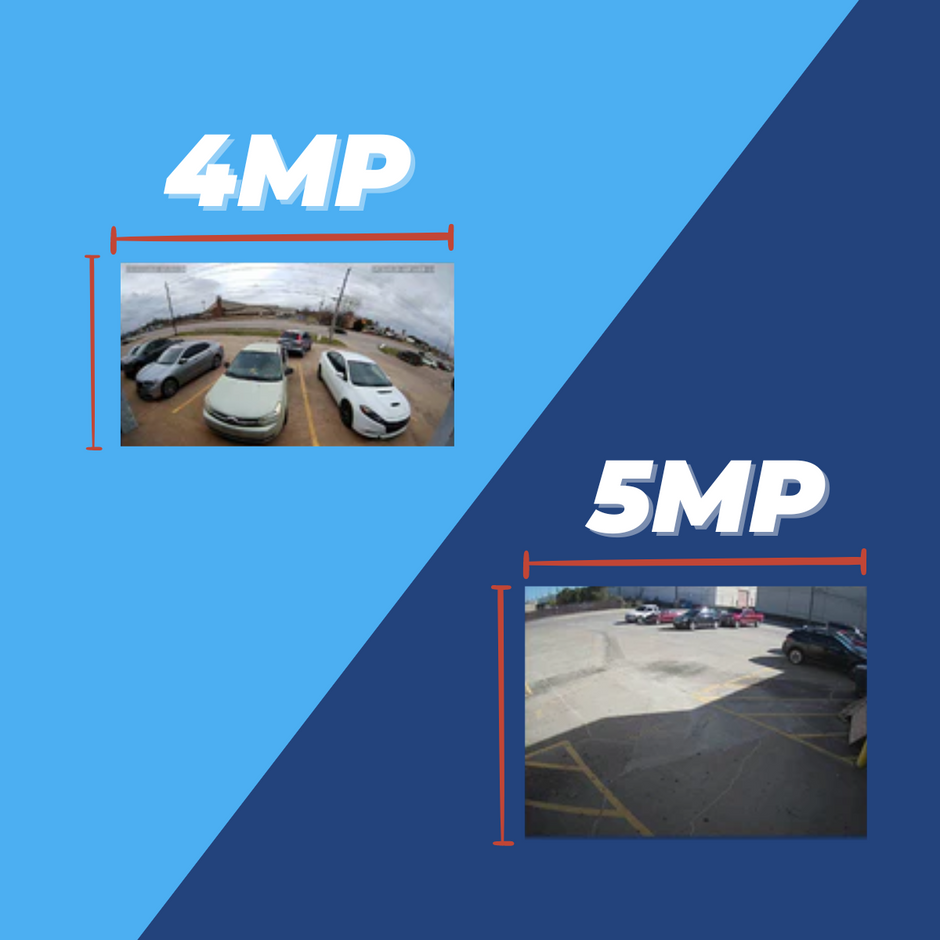Standard PTZ security cameras tend to be large, bulky, heavy, and all-around cumbersome. They're difficult to install and use. Not to mention, they're pretty expensive. These large, heavy-duty PTZ cameras definitely have their place in a video surveillance system. But sometimes you could use the convenient features of a PTZ in a smaller, more manageable, more affordable form factor.
We've already reviewed our Uniview indoor mini PTZ cameras, which combine the powerful features of a full PTZ with the convenience of an indoor camera. Now, after making you wait far too long, here is our official review of Uniview's four outdoor mini PTZ security cameras.
These cameras are incredibly lightweight, compact, and manageable. They're available at a much nicer price point than some larger PTZs. And they're definitely not lacking in features.
From PTZ presets and patrols, to autotracking, to human body detection, to crisp and clear two-way audio, to 164' IR distance, to LightHunter technology, these cameras are packed with incredible specs and features to complete any video surveillance system, whether it's for your home or business.
Meet the Four Models
These outdoor mini PTZ cameras come in four separate models: the standard PTZ, the active deterrence PTZ, the Wi-Fi PTZ, and the lighter Pan & Tilt model. All four cameras are similar in terms of specs, features, and camera housings. However, there are a few key differences that set these cameras apart. So let's talk about the similarities and differences between these four cameras.
The Standard PTZ

The IPC672LR-AX4DUPK is Uniview's standard outdoor mini PTZ. It has all the basic PTZ functions that you would expect from a full outdoor PTZ combined with lightweight, compact convenience. This is a 2MP FullHD 1080p security camera. It shoots video at 30 frames per second. It has a 164' IR distance and LightHunter illumination technology for color video in low-light scenarios. This camera has edge storage capabilities as well as 2-way audio. It's IP66 weatherproof so you can install this camera anywhere.
When it comes to PTZ-specific functions, this camera has a 345° pan, a 90° tilt, and a 4X zoom with a 2.8 - 12mm optical zoom lens. Just like you'd expect, the autofocus on this camera works effortlessly and instantly, even as the lens zooms in and out. It also has autotracking and smart human body detection. It can store up to 256 PTZ presets and 16 PTZ preset routes.
I know that's a lot of information. We'll break it all down here throughout the rest of this blog post. But for now, let's move on to the other two cameras.
The Active Deterrence PTZ
The IPC672LR-AX4DUPKC is essentially the same exact camera as the standard model. It has the same housing, the same specs, and the same features. The difference is that this camera also has active deterrence features. It has a red and blue strobe light, a floodlight, and vocal warnings to ward off potential tresspassers. This camera is the most feature-packed camera of the four, simply because of those active deterrence features.

The Wi-Fi PTZ
<>The newest addition to the Mini PTZ lineup is Uniview’s Wi-Fi PTZ, the IPC672LR-AX4DUWK. This camera has all the incredible specs of the original Mini PTZ model with two additional Wi-Fi capabilities. First, this camera can connect to your network via Wi-Fi. This is a convenient way to get your camera set up without having to run extra network cables. A secondary Wi-Fi function is its hotspot feature. If you have your camera set up on your network via a network cable, your PTZ can act as a Wi-Fi hotspot to connect other cameras and devices. Note that if you connect your Wi-Fi camera via a network cable, you will still have to power your camera with a separate 12V DC power supply. Unlike the other three PTZs, this camera does not take PoE. Since this model came later, you won't see it in the original review. But we did make a follow-up video featuring this model, which you can find on our YouTube channel.

The Pan & Tilt Model
Finally, the IPC672LR-ADUPKF40 is a lighter version of the standard model. It has most of the same specs and features. The difference is in the lens. This camera has a fixed 4mm lens, so it's not really a PTZ; technically it's just a PT. It still has the same 345° pan and 90° tilt, so it does still have all the same PTZ functions as the other two models. It does have presets, routes, autotracking, and human body detection.
Another difference is the IR range. It doesn't have the same 164' IR distance of the other two models. Instead, it has a slightly lower 98' IR distance. However it does still have that awesome LightHunter technology for low-light scenarios.
Other than the fixed lens and 98' IR distance, all the other features and specs are identical to the standard PTZ model.

Uniview's Mini PTZ Image Quality
Before we get to some of the sexier features, like autotracking and active deterrence, let's focus on some of the basic specifications. These are 2MP FullHD 1080p IP security camera. So they don't have the highest resolution that we offer, but it's still a pretty good image. Especially since these cameras shoot video at a smooth frame rate of 30 frames per second. Check out the images and video below to get an idea of this camera's core functionality.

2MP RESOLUTION
It's not the highest resolution in the world, but it's still pretty good. Since three of these four models have that 4x zoom, you'll still be able to zoom in when you need to pick up on the finer details. Plus, that awesome 30fps makes up for the lower resolution!

NIGHT VISION IR RANGE
All four of these cameras have a pretty good IR range. The Pan & Tilt model has the shortest distance at 98'. But the standard PTZ, active deterrence PTZ, and Wi-Fi PTZ each feature an extended 164' IR distance. Check out some samples below.

LIGHTHUNTER ILLUMINATION TECHNOLOGY
With Uniview's LightHunter technology, these cameras have an exceptional low-light sensor with a miminum illumination of .01 lux. This means it can record pretty good quality video in full color even in low-light scenarios. Keep in mind, it's not nearly as low-light optimized as our H-Series NiteColor cameras. Check out the images and video below for a comparison. Keep in mind that our offices are located on a pretty busy streeth with lots of cars, street lights, and businesses. We have a lot of ambient light, so you may not get an image this clear in a darker neighborhood. Again, if you're looking for something with insane low-light performance, you can check out our NiteColor cameras here.
PTZ Functions
Now we're getting to the fun part. Let's talk about the PTZ functions on these four cameras. To do this, we'll break it up into three sections: PTZ controls, PTZ settings, and PTZ events.

PTZ CONTROLS
All four cameras have similar PTZ controls, with the obvious exception of the Pan & Tilt model which lacks zoom functions. Other than that, it's pretty standard and what you might expect for just about any PTZ. As we already mentioned, these cameras have a 345° pan and a 90° tilt, complete with 256 PTZ presets and 16 PTZ routes. Setting and calling the PTZ presets can be done with the click of a button on your NVR or your camera's web interface.

PTZ SETTINGS
When it comes to the behind-the-scenes, there are a few additional PTZ settings. For instance, you can choose a preset or route to be your PTZ's home location, where it will return after a set amount of idle time. You can also set up PTZ limits if you don't want your camera to have full access to its entire pan and tilt field. Maybe, for instance, you don't want your camera to be able to point toward your neighbor's window. Simply set a limit on the web interface to prevent the lens from turning past a certain point.
When it comes to the behind-the-scenes, there are a few additional PTZ settings. For instance, you can choose a preset or route to be your PTZ's home location, where it will return after a set amount of idle time. You can also set up PTZ limits if you don't want your camera to have full access to its entire pan and tilt field. Maybe, for instance, you don't want your camera to be able to point toward your neighbor's window. Simply set a limit on the web interface to prevent the lens from turning past a certain point.
PTZ EVENTS
Each of these cameras support two intelligent events: autotracking and human body detection. While these are technically two separate events, they do work together. So it's probably best to think of these as one overarching intelligent event with two individually configurable parts. Did that make sense? Let me try to explain.
Each of these cameras support two intelligent events: autotracking and human body detection. While these are technically two separate events, they do work together. So it's probably best to think of these as one overarching intelligent event with two individually configurable parts. Did that make sense? Let me try to explain.

The Necessity of Smart Motion Detection
Anytime you have a PTZ camera autotracking people, you really want to have some sort of motion detection filter. Especially if that autotracking PTZ also uses active deterrence features. Standard pixel-based motion detection is great for setting up recording schedules, but it's not ideal for many other applications. The reason behind this is the amount of false alarms you get with standard motion detection. Anytime a leaf blows in the wind, or a bug flies by the camera's lense, or shadows shift in the scene, the motion detection alarm will trigger. You can see how this would be an issue with an autotracking PTZ. The camera would constantly be following cars, bugs, leaves, etc. And you can really see how this would be an issue with active deterrence. It kind of defeats the purpose of having a strobe light to warn off potential intruders if your strobe light is just constantly flashing.
That said, these PTZs don't use standard motion detection for the autotracking or active deterrence features. They use a specialized algorithm that is able to recognize the shape of human bodies and filter out all other types of motion. This means these cameras will only track human bodies.
Here's where it gets a little confusing. The "Human Body Detection" intelligent event is not the same thing as the "Human Body Detection" algorithm. The human body detection algorithm cannot be enabled or disabled. This algorithm is always in use, whether or not the human body detection intelligent event is enabled.
In a nutshell, both the Autotracking intelligent event and the Human Body Detection intelligent event use the human body detection algorithm. Got it? Good. Let's continue.
The Autotracking Event
With Autotracking enabled, your PTZ will automatically follow people around, wherever they go. Again, autotracking uses that human body detection algorithm, regardless of whether or not the human body detection inteliigent event is enabled. So if you have your PTZ installed next to a busy street like we do, you don't have to worry about your camera spending the whole day following cars back and forth. It will only follow people.
The autotracking motor only uses the pan and tilt vertices of your camera. It will not use the zoom function. Because of this, autotracking works exactly the same way on all four models, even the zoomless Pan & Tilt model.
With autotracking enabled, you can choose to let your camera follow its target indefinitely or put a time limit to it. For instance, if someone is moving around for an extended period of time, you can choose whether your camera follows that person the entire time they're moving within your camera's field of view or if you want your camera to ignore that person after a set amount of time, between 1 and 300 seconds.
You can also set up a plan for your camera's autotracking. If you set your camera up in a high traffic location with lots of human movement, you may only be interested in autotracking during less trafficky hours, like at night. To do this, simply set up a plan to tell your camera when to track and when not to track.
And that's pretty much it for autotracking. Keep in mind that there are no triggers to set up. When you enable autotracking, you're just telling your camera to follow people. You're not telling your camera to start a recording or to set off active deterrence features. For that, let's move on to the next intelligent event.
The Human Body Detection Event
The Human Body Detection event allows you to set additional parameters on the human body detection algorithm. It's worth repeating: enabling or disabling the Human Body Detection intelligent event does not enable or disable the human body detection algorithm. So, what are the additional parameters you can set?
First, you can limit your human body detection area to a certain part of the screen. Let's say, for instance, you don't want your camera to acknowledge people walking down the sidewalk. You only want your camera to acknowledge anyone setting foot into your parking lot or driveway. All you have to do is create a new area and draw a box around the spot where you want your camera to pay attention to human body movement.
With the Human Body Detection intelligent event, you can also set up triggers. This is how you can trigger your camera to start recording to your SD card. If you have this connected to an NVR, you can also configure human body detection from the NVR to start recording to the hard drive. And yes, if you have the active deterrence camera, this is where you'll set up those features. But we'll hold off on that until the next section.
I hope this explanation clears things up a bit. Again, it's easier if you think of these two intelligent events as one larger event: human body detection. Each individual event -- autotracking and human body detection -- just gives you different ways to interact with that larger algorithm.
Active Deterrence Features
So far we've looked at all four mini PTZ cameras generally. Now we're going to focus in on one particular model: the IPC672LR-AX4DUPKC. This mini PTZ has all the features we've talked about so far plus additional active deterrence features.
When we talk about active deterrence security cameras, we're talking about cameras that actively draw attention to themselves, thus actively deterring potential criminals and trespassors. These cameras are ideal in many situations where you want your security cameras to be noticeable. For a fuller explanation of what active deterrence is, check out our blog post featuring our H-Series active deterrence cameras.
These Uniview PTZs have two separate active deterrence features: visible cues and audible cues. Both cues are available as triggers to the "Human Body Detection" intelligent event. You can choose to enable either trigger separately or both triggers at the same time.

STROBE & FLOOD LIGHT WARNINGS
This camera is equipped with two sets of lights: a red and blue strobe light on top of the PTZ and a flood light located just under the camera's lens. You can set up the strobe light to flash anywhere between one time and 600 times. At night, the flood light will also turn on. The floodlight moves with the lens. This means if auto tracking is enabled, the floodlight will also track whoever set off the alarm.
What's cool is the camera will automatically switch from IR mode to color mode once the floodlight turns on. With the LightHunter technology, you'll be able to watch any saved recordings of the human body detection event in colorful detail. Check out the video below to see what I'm talking about!
This red and blue strobe light combined with the bright flood light will be sure to warn any potential intruders that you are recording their every move.

VERBAL WARNINGS
Much like the stroble light warning, you can also choose to have the camera give an audible warning to the possible intruder once the human body detection event is triggered. There are ten different pre-installed sounds to choose from, but you can also upload your own sound. The sounds that come with the camera are...
- "You are in the alrt area! Please leave!"
- "You are in the danger zone! Do not approach!"
- "Please be aware! You are in the monitored area!"
- "No parking! Please leave!"
- "Important place! Please leave!"
- "Private area! Do not enter!"
- "Danger! Deep water!"
- "Danger! Do not climb!"
- "Welcome!"
- "Warning!"














